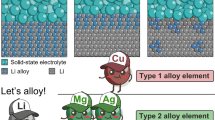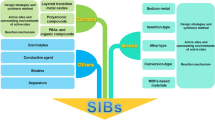Abstract
Detailed elemental analysis is essential for a successful development and optimization of material systems and synthesis methods. This is especially relevant for Li- and Na-containing compounds, found in state-of-the-art and next-generation battery systems. Their materials’ properties and thus the final device performance strongly depend on the crystal structure, the stoichiometry, and defect chemistry, e.g., influencing charge carrier concentration and activation energies for vacancy transport. However, a detailed quantitative analysis of light elements in a heavy matrix, featuring a broad range of solubilities and vapor pressures, is often difficult and associated with large uncertainties and thus neglected in favor of just reporting the stoichiometry as “weighed in.” In this work, we report several approaches to digest and dissolve various oxide and sulfide-based materials, used in next-generation Li batteries, for elemental analysis via optical emission spectroscopy. These include the most common solid electrolytes Li-La-Ti–O, a perovskite material (LLTO), and Li-La-Zr-O which has garnet structure (LLZO). Additionally, a facile thermal digestion process is reported for a surrogate sulfide solid electrolyte (Na2S). The digestion procedures reported here are suitable for almost any laboratory environment and, when applied, will improve understanding of the synthesis-structure–property correlations needed to advanced batteries with all solid-state configurations.





Similar content being viewed by others
References
Abreu-Sepúlveda M et al (2016) Synthesis and characterization of substituted garnet and perovskite-based lithium-ion conducting solid electrolytes. Ionics 22:317–325
Okumura T et al (2011) Improvement of lithium ion conductivity for A-site disordered lithium lanthanum titanate perovskite oxides by fluoride ion substitution. J Mater Chem 21:10061–10068
Han X et al (2017) Negating interfacial impedance in garnet-based solid-state Li metal batteries. Nat Mater 16:572–579
Narayanan S, Hitz GT, Wachsman ED, Thangadurai V (2015) Effect of excess Li on the structural and electrical properties of garnet-type Li6La3Ta1.5Y0.5O12. J Electrochem Soc 162:A1772–A1777
Thangadurai V, Weppner W (2005) Li6ALa2Ta2O12 (A = Sr, Ba): novel garnet-like oxides for fast lithium ion conduction. Adv Funct Mater 15:107–112
Gordon ZD, Yang T, Gomes Morgado GB, Chan CK (2016) Preparation of nano- and microstructured garnet Li7La3Zr2O12 solid electrolytes for Li-ion batteries via cellulose templating. ACS Sus Chem & Eng 4:6391–6398
Shimonishi Y et al (2011) Synthesis of garnet-type Li7−xLa3Zr2O12−1/2x and its stability in aqueous solutions. Solid State Ionics 183:48–53
Thompson T et al (2015) A tale of two sites: on defining the carrier concentration in garnet-based ionic conductors for advanced li batteries. Adv Energy Mater 5:1500096
Buschmann H, Berendts S, Mogwitz B, Janek J (2012) Lithium metal electrode kinetics and ionic conductivity of the solid lithium ion conductors “Li7La3Zr2O12” and Li7−xLa3Zr2−xTaxO12 with garnet-type structure. J Power Sources 206:236–244
Wagner R et al (2016) Crystal structure of garnet-related Li-ion conductor Li7–3xGaxLa3Zr2O12: fast Li-ion conduction caused by a different cubic modification? Chem Mater 28:1861–1871
Allen JL, Wolfenstine J, Rangasamy E, Sakamoto J (2012) Effect of substitution (Ta, Al, Ga) on the conductivity of Li7La3Zr2O12. J Power Sources 206:315–319
Tsai C-L et al (2015) High conductivity of mixed phase Al-substituted Li7La3Zr2O12. J Electroceram 35:25–32
Rangasamy E, Wolfenstine J, Allen J, Sakamoto J (2013) The effect of 24c-site (A) cation substitution on the tetragonal–cubic phase transition in Li7−xLa3−xAxZr2O12 garnet-based ceramic electrolyte. J Power Sources 230:261–266
Ohta H et al (2012) Lithium-ion conducting La2/3−xLi3xTiO3 solid electrolyte thin films with stepped and terraced surfaces. Appl Phys Let 100:173107
Pfenninger R, Struzik M, Garbayo I, Stilp E, Rupp JLM (2019) A low ride on processing temperature for fast lithium conduction in garnet solid-state battery films. Nat Energy 4:475–483
Mann M et al (2021) Evaluation of scalable synthesis methods for aluminum-substituted Li7La3Zr2O12 solid electrolytes. Materials 14:6809
Malkowski TF et al (2021) Role of pairwise reactions on the synthesis of Li0.3La0.57TiO3 and the resulting structure–property correlations. Inorg Chem 60:14831–14843
McAuliffe RD et al (2021) Synthesis of model sodium sulfide films. J Vac Sci Tech A 39:053404
Tsai C-L et al (2016) Li7La3Zr2O12 interface modification for li dendrite prevention. ACS Appl Mater Interfaces 8:10617–10626
Badami P et al (2020) Highly conductive garnet-type electrolytes: access to Li6.5La3Zr1.5Ta0.5O12 prepared by molten salt and solid-state methods. ACS Appl Mater Interfaces 12:48580–48590
Zheng Z, Zhang Y, Song S, Wang Y (2017) Sol–gel-processed amorphous inorganic lithium ion electrolyte thin films: sol chemistry. RSC Adv 7:30160–30165
Zheng Z, Song S, Wang Y (2016) Sol-gel-processed amorphous lithium ion electrolyte thin films: structural evolution, theoretical considerations, and ion transport processes. Solid State Ion 287:60–70
Acknowledgements
The authors would like to thank Dr. Tim Armstrong (Steward Advanced Materials—Chattanooga TN) for the commercial samples of solid electrolytes. GMV would like to thank Diana Stamberga in ORNL’s Chemical Separations Group for repeated access to the ICP used in this work and the high level of safety instilled in her laboratories. Work at ORNL (TFM, EOB, GMV – LLTO, LLZO digestion, Na2S) was supported by the U.S. Department of Energy, Office of Science, Basic Energy Sciences, Materials Science and Engineering. Work at Julich was conducted as part of the US-German joint collaboration on “Interfaces and Interphases In Rechargeable Li-metal based Batteries” supported by the US Department of Energy (DOE) and German Federal Ministry of Education and Research (BMBF). Financial support from the BMBF within 03XP0223A. Additionally, funding from the German Federal Ministry of Education and Research (BMBF) under grant no.: 13XP0173A (FestBatt-Oxide) and 13XP0434A (FB2-Oxide) is gratefully acknowledged. This manuscript has been authored by UT-Battelle, LLC, under contract DE-AC05-00OR22725 with the US Department of Energy (DOE).
Author information
Authors and Affiliations
Corresponding author
Additional information
Publisher's Note
Springer Nature remains neutral with regard to jurisdictional claims in published maps and institutional affiliations.
This manuscript has been authored by UT-Battelle, LLC, under contract DE-AC05-00OR22725 with the US Department of Energy (DOE). the U.S. government retains and the publisher, by accepting the article for publication, acknowledges, that the US government retains a nonexclusive, paid-up, irrevocable, worldwide license to publish or reproduce the published form of this manuscript, or allow others to do so, for US government purposes. DOE will provide public access to these results of federally sponsored research in accordance with the DOE Public Access Plan (https://energy.gov/downloads/doe-public-access-plan)
Rights and permissions
About this article
Cite this article
Malkowski, T.F., Boeding, E.D., Fattakhova-Rohlfing, D. et al. Digestion processes and elemental analysis of oxide and sulfide solid electrolytes. Ionics 28, 3223–3231 (2022). https://doi.org/10.1007/s11581-022-04536-0
Received:
Revised:
Accepted:
Published:
Issue Date:
DOI: https://doi.org/10.1007/s11581-022-04536-0




